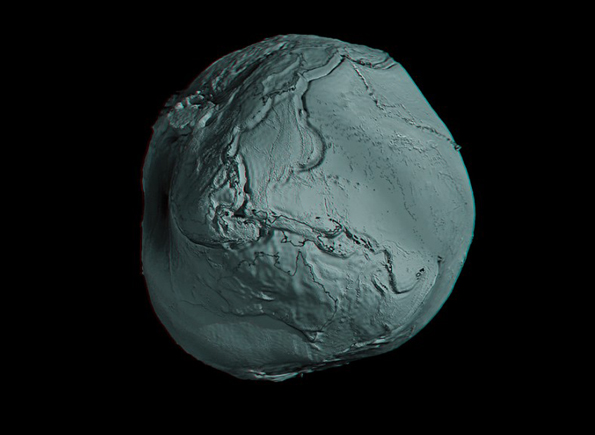
Herman Hesse’s The Glass Bead Game (1943) imagined a peculiar society set some five hundred years in the future, in which Castalia, a province of central Europe, is entirely designated as a place for the pursuit of pure knowledge. In this cloistered setting cut off from the world and its historical and political vicissitudes, the monastic inhabitants of Castalia, unencumbered by technological or economic concerns, are free to develop obscure objects of enquiry devoid of practical implications in the world extending beyond its dusty halls. The apex of this ineffectual scholarly order is the mastery of a complex interdisciplinary game that synthesizes all forms of knowledge, in which musical motifs, philosophical propositions and scientific formulae all occupy the same rarified epistemic space.
Castalia is an equivocal image: at once a hyperbolic caricature of Enlightenment reason’s pretensions to the autonomy, neutrality and normative objectivity of knowledge; and at the same time an idyllic respite from the political, technical and socio-economical embodiment of such forms of knowledge, whose dramatic consequences were all too evident in the horrors of industrial warfare surrounding Hesse. Castalia figures a conception of logic in which the synthesis of knowledge is achieved at the cost of its seclusion from the world, and the global structure of thought remains unchanged by its own actions.
The modern institution of art as a space of exceptionality prolongs and dramatizes this equivocal construction. Considered in excess and in exception to rational operations, art has produced forms of mediation and synthesis at the price of their operative inconsequentiality. This script of exceptionality has been left intact in the postmodern 'expanded field' of art. The truth content or value of art thus appears caught in a vortex of social relativism in which all foundations are considered lost, and in which a simulacral play of mirrors swarms out and distorts all particularity or universality.
The relativistic critique of rationality has revealed the normative structures that these equivocal images repressed. But it has also caricatured rationality, identifying it with fixed ontologies and tautological axiomatic foundations. Following this critique, the hierarchical privilege historically accorded to the universal over the particulars it subsumes is overturned, so that it is difference that prevails, and that is taken to undermine the objectivity of rational discourse.
On the contrary, we may say that reason is primarily socially embodied in practical and conceptual discourses, and that formal logics should be seen as the explicitation of the logical rules that are implicit in everyday behaviour. Logic now pervades our lives in another way, largely opaque to common understanding, in the computer scientific development of diverse automated algorithmic systems. In this fast evolution of computational technologies, it becomes again essential to pose questions regarding ontology, rationality, and normativity; as well as to explore again the dialectic between figures and backgrounds, particulars and universals, authority and responsibility.
History did not end, and in its background scientific reason has continued to irreversibly alter the field of knowledge. Mathematics and logic developed undeterred by the loss of foundations, indeed because of this unmooring. The same year The Glass Bead Game was published, two mathematicians (Samuel Eilenberg and Saunders Mac Lane) undertook the development of transit rules that would lead to the basis of category theory, and opened the possibility for truly synthetic forms of reasoning across many other disparate systems. Initially developed as a mathematical paradigm that could act as a universal medium facilitating transits between increasingly specialised mathematical languages, category theory has recently started to be applied in different fields, notably in systems biology, and in computer science, where it develops as an alternative to object oriented programming. The fundamental unit of interest for category theory is not the object but the morphism, or transformation, according to which the dynamics of an object, system or process may be defined, by showing their variables and invariants under transformation. This radically alters the conceptualization of particularity and universality, since there is a rigorous mathematical language that allows for their redescription in terms of locality and globality, yielding the possibility of a relativist yet absolute knowledge.
Morphing Castalia is an investigation of this model in which thinking transforms thought. The issue is not to rebuild the old foundationalist dream of a completed universal language; neither to reconduct the standard critique of rationality, but to construct the conditions for universal transits transforming the sites between which they operate. Looking for the possibility to engage with these sites in ways that would not privilege their local inscription over their global resonance, Glass Bead started its inquiry in April 2014 in New York by focusing on navigation and gestures as concepts through which it can be possible to operate these transits. At Les Laboratoires d’Aubervilliers this fall, Glass Bead pursues this investigation by exploring how such transits could be developed further by examining the ways in which synthetic approaches that have emerged in contemporary mathematics can be seen to affect cultural, biological, technological, and political landscapes.
The week has comprised three evenings of public lectures, each followed the next day by a private workshop leading to an interview of the speakers dedicated to the crafting of transits between their respective practices. All material is available on Glass Bead’s website.
Glass Bead was conceived and is run by Fabien Giraud, Jeremy Lecomte, Vincent Normand, Ida Soulard and Inigo Wilkins.
Speakers:
Andrée C. Ehresmann (mathematician), Olivia Lucca Fraser (philosopher)
Martin Holbraad (anthropologist), Franck Jedrzejewski (philosopher, mathematician, musicologist), Giuseppe Longo (mathematician, logician, epistemologist), Frederik Stjernfelt (philosopher)
Workshop participants:
Mathias Béjean (researcher at Mines Paris Tech), Katrina Burch (researcher), Étienne Chambaud (artist), Tristan Garcia (philosopher, writer), Valeria Giardino (philosopher), Sonia de Jager (researcher), Margarida Mendes (director of The Barber Shop, Lisbon), Patricia Reed (artist, writer), Olivier Surel (philosopher and PhD candidate at Université Paris Ouest), Ferhat Taylan (philosopher), Tzuchien Tho (Post-Doctoral Fellow at the Max Plank Institut fur Wissenschaftsgeschichte, Berlin), Max Turnheim (architect)
Image: GEOID - "the Mathematical figure of the Earth" C.F. Gauss
Credits: ESA/HPF/DLR, anaglyph by Nathanial Burton-Bradford.
























